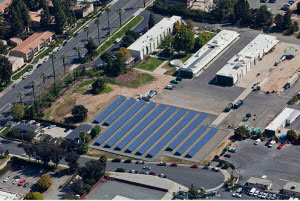The Forest Service’s first net-zero energy building has received the 2013 GreenGov Presidential Award and the US Department of Energy’s 2013 Federal Energy and Water Management Award.
The award is for the renovation of the 48-year old Technology and Development Center in San Dimas, California – the hub for fire-fighting equipment and related problem-solving efforts in the West.
The building will produce more than double the energy it consumes by typical upgrades such as replacing the HVAC system, and installing 302 kilowatts of ground mounted solar on 1.5 acres of land.

In fact, the Forest Service’s Northern Region negotiated a 13-year, $2.6 million energy savings contract that will retrofit 500 facilities at 62 sites served by 19 different utility providers. The complex contract will result in upgrades that include programmable thermostats, heat pumps, lighting, vacancy sensors, attic and foundation insulation, infiltration reduction measures and a 4.9 kW solar PV system.
Expected to save $250,000 in utility bills a year, it’s being used as a template for for two other Forest Service regions. Since the fire-fighting budget is nowhere near enough to battle the surge in climate-related wildfires, they certainly can use the savings.
The annual White House GreenGov awards honor innovative programs that significantly cut energy use and carbon pollution while saving taxpayers’ money. It was implemented in 2009 after President Obama’s first executive order that required federal agencies to set goals within 90 days for reducing greenhouse gas emissions by 2020.
Growth in Net-Zero Energy Construction
While the total number of net-zero energy buildings remains small, "the growth and diversity are
important indicators for what we should expect in the coming years,” notes Ralph
DiNola, executive director of New Buildings Institute (NBI), which tracks the growth of these buildings.
"We are seeing this play out in the shift from a handful of
projects primarily in the public domain, to private companies such as Walgreens
and TD Bank embarking on these building projects and using those experiences to
inform future development,” he says.
There are 33 verified net-zero energy buildings in North America and 127 more that await verification after gathering a full year of energy data. 53 other buildings have levels of efficiency comparable to net-zero but don’t have sufficient onsite renewable energy. In all, there are 213 buildings, up from 99 buildings in 2012, according to NBI.
NBI’s report, 2014 Getting to Zero Status
Update finds that net-zero energy buildings are:
- achievable in all regions and climate zones: they are currently in 36 states and two Canadian
provinces that cover all eight climate zones. - possible in many building types and sizes: current buildings are spread across K-12 schools and universities offices, low-rise apartment buildings and merging labs ratory
buildings. Half are over 100,000 square feet.Education buildings such as K-12 schools and universities, make up the single largest category this year, with a third of all net-zero buildings. An example is the Center for Energy Efficient Design, a net-zero learning lab for middle school students in Rocky Mount, Virginia.
- achievable for retrofits, not just new construction: 24% of this year’s list is for renovation projects
- net-zero districts are a growing trend: in addition to individual buildings, there is a new
trend of communities and campuses committed to groups of net-zero buildings. NBI identifies 18 Districts,
with the U.S. Army and several universities leading. - increasing interest from the private sector: 26% of net-zero buildings contructed this year were for private corporations.
Some examples they point to:
Anna Maria Historic Green Village in Florida combines historic preservation – four 100-year-old buildings – with state-of-the-art green technology, bringing jobs and economic development to local residents.
TD Bank‘s retail branch in Fort Lauderdale, Florida.
The Ramona in downtown Portland, Oregon, is a mixed-use development with 138 units of affordable housing and two educational facilities.
Last year, a net-zero energy training center opened San Leandro, California, to teach electricians advanced skills in this area. It’s a joint project of the International Brotherhood of Electrical Workers Local Union 595 and the North California Chapter of the National Electrical Contractors Association.
Here’s the report and a map that shows where the buildings are:
